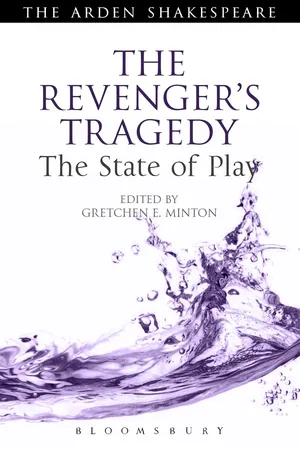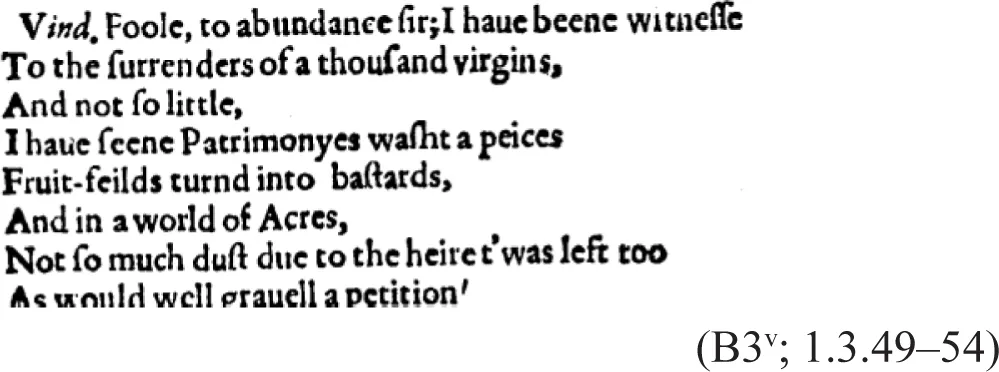
This is a test
- 368 pages
- English
- ePUB (mobile friendly)
- Available on iOS & Android
eBook - ePub
The Revenger's Tragedy
Book details
Book preview
Table of contents
Citations
About This Book
A major new edition of this much studied play offering the standard, depth and range associated with all Arden editions. The on-page commentary notes explain the language, referenes and staging issues posed by the text while the lengthy, illustrated introduction offers a lively overview of the play's historical, performance and critical contexts. This is the ideal edition for study and performance.
Frequently asked questions
At the moment all of our mobile-responsive ePub books are available to download via the app. Most of our PDFs are also available to download and we're working on making the final remaining ones downloadable now. Learn more here.
Both plans give you full access to the library and all of Perlego’s features. The only differences are the price and subscription period: With the annual plan you’ll save around 30% compared to 12 months on the monthly plan.
We are an online textbook subscription service, where you can get access to an entire online library for less than the price of a single book per month. With over 1 million books across 1000+ topics, we’ve got you covered! Learn more here.
Look out for the read-aloud symbol on your next book to see if you can listen to it. The read-aloud tool reads text aloud for you, highlighting the text as it is being read. You can pause it, speed it up and slow it down. Learn more here.
Yes, you can access The Revenger's Tragedy by Gretchen E. Minton, Gretchen E. Minton in PDF and/or ePUB format, as well as other popular books in Literature & Drama. We have over one million books available in our catalogue for you to explore.
Information
APPENDIX 1
Textual analysis
The Revenger’s Tragedy was printed and published in 1607 by George Eld, whose shop was located in Fleet Lane in London. At this location customers could buy the books that he produced throughout his career, which included quartos of early modern plays by Jonson, Shakespeare, Marston, Chapman and others.1 One way of securing the right to publish was by entering plays into the Stationers’ Register, and on 7 October 1607 Eld entered two plays together: The Revenger’s Tragedy and A Trick to Catch the Old One.2 The printing of the Revenger’s Tragedy quarto began late in 1607 and continued into 1608. It was printed on nine sheets of paper (signed A–I), making thirty-six leaves, with a running title from the second page of the play text (sig. A2v) to the last page reading ‘THE REVENGERS TRAGÆDIE’.3 The play is divided into four acts, corresponding to the first four acts in this edition.4 The omission of the act-break beginning at Act 5 might be due to the shortage of space discussed further below, as the final page of the final sheet, sig. I4v, is printed to the bottom.
Jackson has demonstrated that two compositors (whom he designates as X and Y) prepared Revenger’s for the press.5 Each compositor had his own habits of spelling, punctuation and the handling of lineation; thus some differences between sections of the play arise from these vagaries.6 Much more significant for the nature of the printed text, however, is the character of the manuscript from which the compositors were working.7 Bibliographers who have analysed the quarto have argued that the compositors were working from a copy in the author’s own hand, rather than from one that had been prepared by a professional scribe. The evidence for the author’s hand rests upon unusual Middletonian spellings, contractions and linguistic features which match those of the Trinity holograph of Middleton’s A Game at Chess.8 The Revenger’s quarto shows no particular signs that the copy manuscript was marked up for use in the theatre. Foakes and Jackson, for instance, cite the frequent lack of entrances and exits, the descriptive nature of the action, and the lack of theatrical directions for properties or sound effects as evidence for the non-theatrical origins of this text.9 However, Paul Werstine has argued that the absence of such features in early modern printed texts fails to demonstrate that the copy manuscript had not been used in the theatre,10 thus although it is likely that the Revenger’s manuscript was in the author’s hand, the question as to whether it was a playhouse manuscript remains open.
The Revenger’s quarto includes several descriptive stage directions, sometimes outlining gradually unfolding action, such as the following example from the beginning of 4.3:

‘He seemeth lasciuiously to her’ describes an attitude that could be adopted by an actor, or it could be a description to help a reader picture the stage action. In either case, the opening stage direction gives information for the entire short scene before it actually unfolds: Supervacuo runs after the Duchess and Spurio with his rapier only after they exit, then he is stopped by Ambitioso. The long introductory stage direction can make it difficult for readers to understand the relationship between dialogue and stage action.11 One of the choices I have made as part of the modernization of this edition, therefore, is to move, and sometimes to break up, stage directions to accord with the action suggested by the dialogue.
Editorial intervention often addresses irregularity in lineation, which is the most significant difficulty in the Revenger’s text.12 The issue in Revenger’s is complicated by the fact that Middleton himself often changed register as he wrote; as Jackson notes, ‘Middleton’s abrupt transitions from verse to prose and back again, even within a single speech, his tendency at times to nudge either medium towards the other, and his liking for hypermetrical exclamations and short phrases that interrupt the basic iambic pentameter appear to have perplexed the compositors on several occasions and can make it hard to determine the most appropriate setting out.’13 Most of the time I have preserved these shifting registers from the quarto rather than attempting to achieve a visual regularity that Middleton’s writing lacked. For example, when Vindice, in disguise as Piato, attempts to lure his mother into prostituting Castiza, he speaks in verse, while his mother answers in prose:

Many editors have set the Mother’s response in rather irregular verse to match Vindice’s tone, but such an emendation misses the point that her shift to prose corresponds with her initial attempts to resist his advances. After his next speech, she admits that ‘this overcomes me’ (103), and directly after that she speaks not only in verse, but in rhyming couplets. In many places, such transitions between prose and verse echo the relationships between the characters or convey a character’s anger, such as when Spurio breaks into prose when he reflects upon his bastardy at 1.2.135–43.
Middleton’s practices sometimes puzzle the modern editor, but Eld’s compositors experienced similar difficulties, as attested by the places in which they seem to have misunderstood the manuscript. In the midst of a verse exchange between Vindice and Lussurioso in Act 3, the quarto sets the following speech as verse, even though it does not scan as such:

The present edition instead prints this speech in prose, which is a more accurate reflection of its irregular rhythms.
Similarly, sometimes it is necessary to alter the quarto layout to clarify shared lines and rhymes, as in this example:

This could be how Middleton wrote the lines in the manuscript, or the arrangement could reflect compositorial space-saving. In either case, however, the arrangement in Q obscures the underlying aural relationship between these lines, so here I follow the editorial tradition begun with Collins in 1878 which continues the first verse line with Vindice’s ‘Why it hits’ (in keeping with the brothers’ tendency to complete one another’s thoughts), which establishes the rhyming couplet:
HIPPOLITO
Brother, how happy is our vengeance!
VINDICE:Why, it hits
Past the apprehension of indifferent wits.
The rhythmic relationship between characters is similarly important in the following passage, where Vindice continues his beating verse line, scarcely admitting a pause for the Mother’s question:

This is one of several i...
Table of contents
- Cover
- Half Title
- Series
- Title Page
- The Editors
- Dedication
- Contents
- List of illustrations
- General editors’ preface
- Preface
- Introduction
- THE REVENGER’S TRAGEDY
- Commentary Notes and Textual Notes
- Appendix 1
- Appendix 2
- Abbreviations and references
- Index
- Copyright